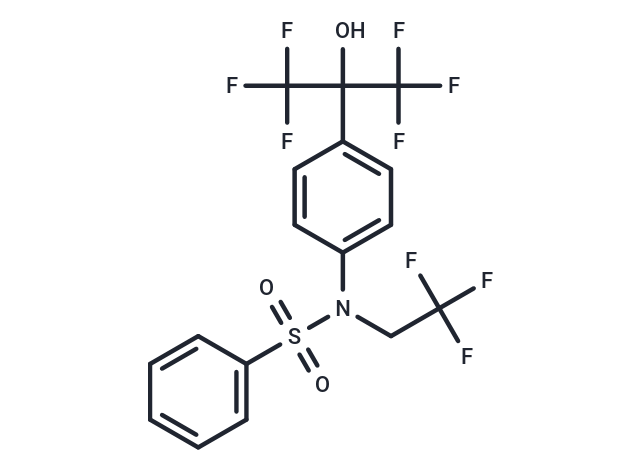Shopping Cart
Remove All Your shopping cart is currently empty
Your shopping cart is currently empty
T0901317 is a potent and selective agonist for both LXR and FXR, with EC50 of ~50 nM and 5 μM, respectively; it inhibits nuclear factor/κB (NF/κB).

| Pack Size | Price | USA Warehouse | Global Warehouse | Quantity |
|---|---|---|---|---|
| 5 mg | $32 | In Stock | In Stock | |
| 10 mg | $52 | In Stock | In Stock | |
| 25 mg | $80 | In Stock | In Stock | |
| 50 mg | $101 | In Stock | In Stock | |
| 100 mg | $159 | In Stock | In Stock | |
| 200 mg | $207 | In Stock | In Stock | |
| 1 mL x 10 mM (in DMSO) | $57 | In Stock | In Stock |
| Description | T0901317 is a potent and selective agonist for both LXR and FXR, with EC50 of ~50 nM and 5 μM, respectively; it inhibits nuclear factor/κB (NF/κB). |
| Targets&IC50 | FXR:5 μM(EC50), LXR:50 nM(EC50) |
| In vitro | T0901317 acts through LXR and in concert with its RXR heterodimerization partner induces the expression of the ABCA1 reverse cholesterol transporter. T0901317 upregulates expression of the ABCA1 gene associated with cholesterol efflux regulation and HDL metabolism.[1] T0901317 displays an EC50 of ~ 5 μM for activation of bile acid farnesoid X receptors (FXRs), 10-fold more potent than natural FXR ligand chenodeoxycholic acid. [2] T0901317, is also a high-affinity ligand for the xenobiotic receptor pregnane X receptor (PXR). T0901317 binds and activates PXR with the same nanomolar potency with which it stimulates LXR activity. T0901317 induces expression not only of LXR target genes, but also of PXR target genes in cells and animals, including the scavenger receptor CD36. [3] T0901317 decreases amyloid-β production in primary neurons in vitro. [4] T0901317 is found to directly bind to RORα and RORγ with high affinity (Ki = 132 and 51 nM, respectively), resulting in the modulation of the receptor's ability to interact with transcriptional cofactor proteins. T0901317 represses RORα/γ-dependent transactivation of ROR-responsive reporter genes and in HepG2 cells reduces recruitment of steroid receptor coactivator-2 by RORα at an endogenous ROR target gene (G6Pase). [5] |
| In vivo | T0901317 treatment of 11-week-old APP23 mice for 6 days shows a significant increase in ABCA1 expression and a decrease in the ratio of soluble APP (sAPP)β- to sAPPα-cleavage products. Most importantly, the treatment causes a statistically significant reduction in the levels of soluble Aβ40 and of Aβ42 in the brain these mice. [4] |
| Molecular Weight | 481.33 |
| Formula | C17H12F9NO3S |
| Cas No. | 293754-55-9 |
| Smiles | C(C(F)(F)F)(C(F)(F)F)(O)C1=CC=C(N(S(=O)(=O)C2=CC=CC=C2)CC(F)(F)F)C=C1 |
| Relative Density. | 1.55 g/cm3 |
| Storage | Powder: -20°C for 3 years | In solvent: -80°C for 1 year | Shipping with blue ice/Shipping at ambient temperature. | ||||||||||||||||||||||||||||||||||||||||
| Solubility Information | DMSO: 130 mg/mL (270.08 mM), Sonication is recommended. Ethanol: 48.1 mg/mL (99.93 mM), Sonication is recommended. | ||||||||||||||||||||||||||||||||||||||||
| In Vivo Formulation | 10% DMSO+40% PEG300+5% Tween 80+45% Saline: 2.5 mg/mL (5.19 mM), Sonication is recommended. Please add the solvents sequentially, clarifying the solution as much as possible before adding the next one. Dissolve by heating and/or sonication if necessary. Working solution is recommended to be prepared and used immediately. The formulation provided above is for reference purposes only. In vivo formulations may vary and should be modified based on specific experimental conditions. | ||||||||||||||||||||||||||||||||||||||||
Solution Preparation Table | |||||||||||||||||||||||||||||||||||||||||
Ethanol/DMSO
DMSO
| |||||||||||||||||||||||||||||||||||||||||
| Size | Quantity | Unit Price | Amount | Operation |
|---|

Copyright © 2015-2025 TargetMol Chemicals Inc. All Rights Reserved.